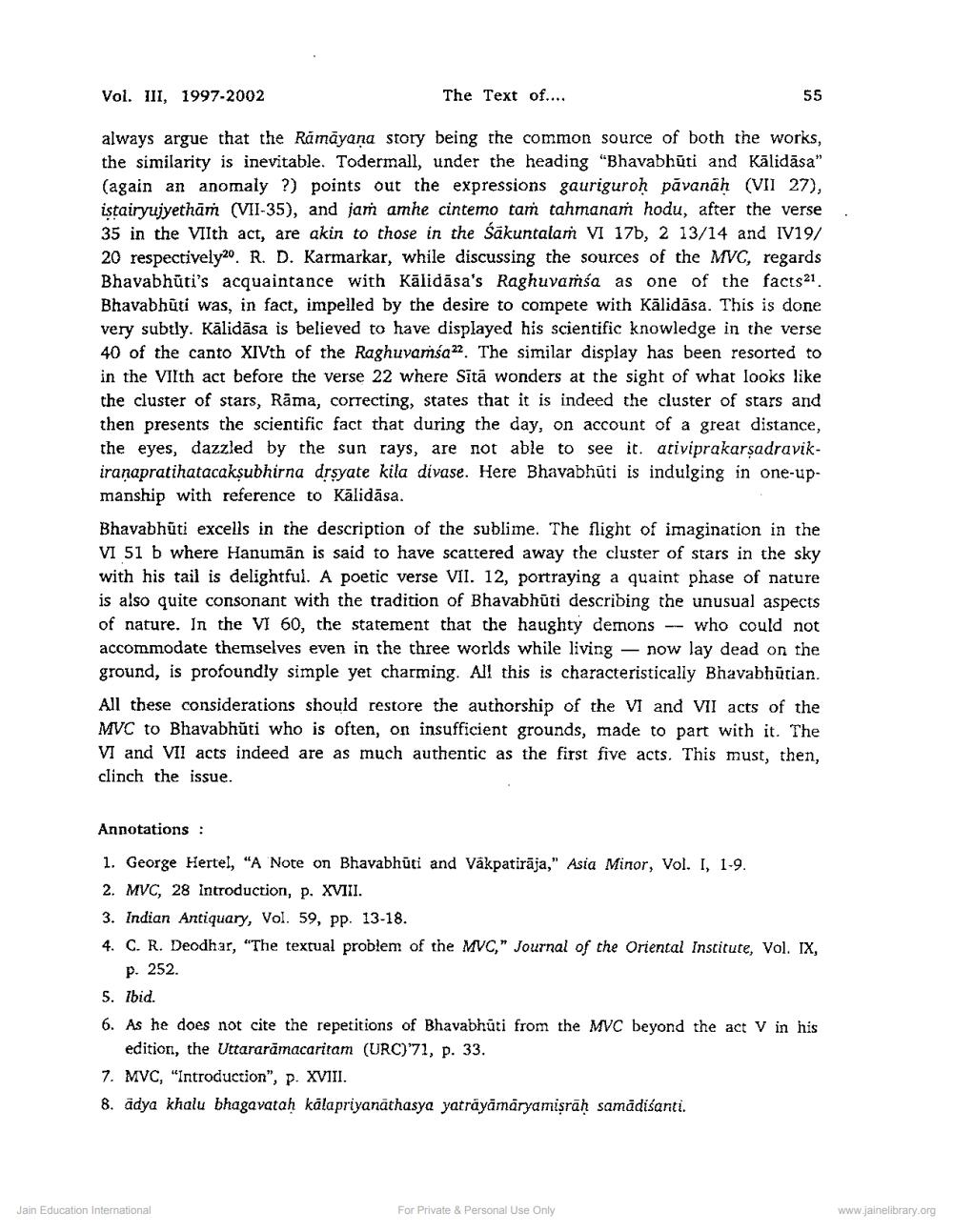Book Title: Text of Mahavircarita of Bhavbhuti Author(s): Vijay Pandya Publisher: Z_Nirgrantha_1_022701.pdf and Nirgrantha_2_022702.pdf and Nirgrantha_3_022703.pdf View full book textPage 8
________________ Vol. III, 1997-2002 The Text of.... 55 always argue that the Rāmāyaṇa story being the common source of both the works, the similarity is inevitable. Todermall, under the heading "Bhavabhūti and Kalidāsa" (again an anomaly ?) points out the expressions gauriguroń pāvanah (VII 27), istairyujyethāṁ (VII-35), and jam amhe cintemo tam tahmanam hodu, after the verse 35 in the VIIth act, are akin to those in the sakuntalam VI 17b, 2 13/14 and IV19/ 20 respectively20 R. D. Karmarkar, while discussing the sources of the MVC, regards Bhavabhūti's acquaintance with Kālidāsa's Raghuvamsa as one of the facts21 Bhavabhūti was, in fact, impelled by the desire to compete with Kālidāsa. This is done very subtly. Kālidāsa is believed to have displayed his scientific knowledge in the verse 40 of the canto XIVth of the Raghuvamsa22. The similar display has been resorted to in the VIIth act before the verse 22 where Sītā wonders at the sight of what looks like the cluster of stars, Rāma, correcting, states that it is indeed the cluster of stars and then presents the scientific fact that during the day, on account of a great distance, the eyes, dazzled by the sun rays, are not able to see it. ativiprakarsadravikiranapratihatacakşubhirna drsyate kila divase. Here Bhavabhūti is indulging in one-upmanship with reference to Kālidāsa. Bhavabhūti excells in the description of the sublime. The flight of imagination in the VI 51 b where Hanumān is said to have scattered away the cluster of stars in the sky with his tail is delightful. A poetic verse VII. 12, portraying a quaint phase of nature is also quite consonant with the tradition of Bhavabhūti describing the unusual aspects of nature. In the VI 60, the statement that the haughty demons -- who could not accommodate themselves even in the three worlds while living – now lay dead on the ground, is profoundly simple yet charming. All this is characteristically Bhavabhūtian. All these considerations should restore the authorship of the VI and vil acts of the MVC to Bhavabhūti who is often, on insufficient grounds, made to part with it. The VI and VII acts indeed are as much authentic as the first five acts. This must, then, clinch the issue. Annotations : 1. George Hertel, “A Note on Bhavabhūti and Väkpatirāja," Asia Minor, Vol. I, 1-9. 2. MVC, 28 Introduction, p. XVIII. 3. Indian Antiquary, Vol. 59, pp. 13-18. 4. C. R. Deodhar, "The textual problem of the MVC," Journal of the Oriental Institute, Vol. IX, p. 252. 5. Ibid. 6. As he does not cite the repetitions of Bhavabhūti from the MVC beyond the act V in his edition, the Uttararāmacaritam (URC)'71, p. 33. 7. MVC, "Introduction", p. XVIII. 8. adya khalu bhagavatah kālapriyanāthasya yaträyāmaryamışrāḥ samādisanti. Jain Education International ducation International For Private & Personal Use Only www.jainelibrary.org For Private & Personal Use OnlyPage Navigation
1 ... 6 7 8 9
